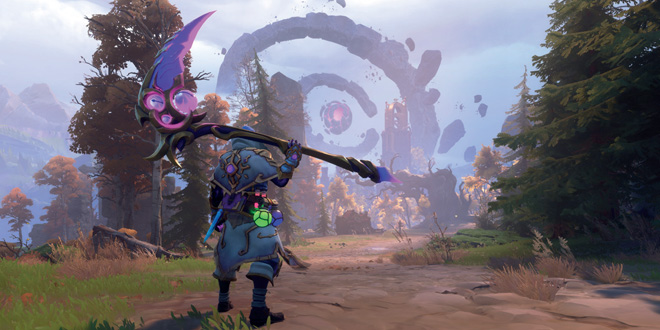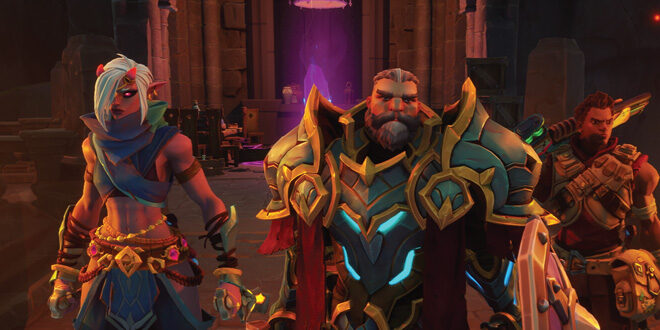 Richard Browne, head of external projects at Digital Extremes tells Vince Pavey all about Wayfinder, its upcoming synth-fantasy collaboration with Airship Syndicate
Richard Browne, head of external projects at Digital Extremes tells Vince Pavey all about Wayfinder, its upcoming synth-fantasy collaboration with Airship Syndicate
Wayfinder is an arcane action-RPG that will see adventurers explore the world of Evenor on a quest to push back the Gloom and bring light back to the world. It’s the latest game from publisher Digital Extremes and studio Airship Syndicate, and has origins that are perhaps surprisingly forged in relationships that were formed back when Airship co-founders Joe Madureira and Ryan Stefanelli first approached THQ with Darksiders.
“It was one of the only games where I’ve actually ever walked out of a pitch meeting and said ‘We have to sign this’” reminisces Digital Extremes’ Richard Browne, then in charge of global external development at THQ. “I’ve kept in touch with [Joe and Ryan] ever since. Airship grew and built Battle Chasers, then built the next Darksiders and they were building Ruined King. We started chatting about four years ago about what they wanted to do next. That’s how Wayfinder came about.” Digital Extremes is obviously very well-known for its work on Warframe, the massively popular online sci-fi RPG, but another online RPG game like Wayfinder wasn’t necessarily on the cards as its next move.
“Digital Extremes often worked as a work-for-hire company, but when Warframe took off, they had several years of amazing success and wanted to do something else,” explains Browne. “It was then a question of ‘how do you expand, without getting insanely big?’ and so the logical route was ‘okay, we should find other developers and give them the same opportunity’. We knew there were lots of other work-for-hire studios out there who had the incredible ability to create great things, but were just never given the chance. So we started looking around. Airship was the first one we came across where we both wanted exactly the same thing. We both had incredible ambition.”
Wayfinder isn’t the first time the company has tried its hand at external publishing, but it does show a change in what it wants to create with its partnerships with developers from outside the company.
“Digital Extremes as a company had played with trying to do this previously and done a couple of smaller projects that didn’t really work out,” says Browne. “When I came on board, I told James that we should try and be a little more ambitious and if we’re going to do projects, they should try and be games that could sit alongside Warframe. We upped our ambition level a little bit and started looking at developers who we felt could create the same level of AAA quality that we do.”
DIGITAL SYNDICATE

The Warframe developer-publisher has been focused on its sci-fi ninja space opera for so long that you could reasonably expect that realigning to deliver a second online game as a publisher might have proven to be a difficult task. That’s not the case, though. It’s more a matter of partnership logistics and planning, rather than diverting resources.
“We have a development team split pretty much across the world like everybody these days,” says Browne. “But the main team at Airship Syndicate is around 70. Then we have outsourcing groups and my team in Digital Extremes who help out on the design and the art and the technology side of things. If you include all the outsourcing groups, it’s probably more than 100.”
The fact of the matter is that a lot of the Warframe team at Digital Extremes won’t touch the work on Wayfinder at all. “It’s a very separate effort. There’s the Warframe team, and there’s our external projects team. Where it crosses over is in stuff that we can help with, or provide experience and knowledge to the developer on. So primarily we’re a publisher, and we’ve been doing that for 10 years.
“In some respects, we’ve done it longer than most. We were one of the first to get to the free-to-play realm in the west. We’ve run that business, so we bring a lot of stuff to the table that developers just don’t have. When we went to talk to Airship, the game they were pitching was not a free-to-play online games-as-a-service project. It was an extension of the games they’d done previously. We bring a lot of experience to the table in the digital publishing realm, and also in the free-to-play area, so things changed a bit.”
Despite the games being separate enterprises, the time spent on Warframe comes with experience, and development lessons learned. Digital Extremes intends to leverage that, so that Wayfinder can have a smoother launch than its forerunner, particularly in regards to its post-release content plan.
“We learned a lot in the early days of Warframe about how to scale a game like that, and content production and pipelines. So from a technology and production standpoint, we’ve learned an awful lot about how you keep an online game updated very rapidly,” says Browne.
“We’ve also learned a lot about community. Warframe probably has the best community online. That’s a lot to do with how open we are and how approachable we make ourselves. We’re not in any way a barrier between development and the community. That’s something we will continue with Wayfinder, and the development team will be talking one-to-one with the audience. The core basis of how we approach free-to-play is very different to most. We’ve had some very nice articles written about how Warframe is a free-to-play game that’s not predatory. We brought that forward as well.”
The games-as-a-service ecosystem has evolved during Warframe’s lifetime, thanks to both Digital Extremes’ own efforts and those of other products in the market. Many competitors have come and gone, with GaaS titles that are fun games at their cores seemingly living or dying based on content release cadences and how good studios are at keeping game fans invested.
“The most important thing that’s evolved in the last ten years are the communities,” says an impassioned Browne. “The player base has expectations that things happen on a regular basis, so we make sure that there’s always something new for the player to do. To get a player’s time, we want to involve them in our world. We want to give them something that they fall in love with, to stay invested in. The updates are consistent, so you can rely on them.”
ON THE ROAD

To facilitate their hopes of sticking to a consistent content update plan, Digital Extremes and Airship Interactive have put processes, tools and practices in place to make sure that updating Wayfinder on a regular basis is something that they can reasonably do.
“We do a lot of planning. We have a lot of people working on the game and we’ve got a roadmap that we stick to, and we keep building it day-by-day,” affirms Browne. “The interesting thing about games-as-a-service is that things can change at any time. So you start doing things and the community goes, ‘hey, we love that.’, so you have to slightly move the path and have the people in place to go down that path. You can do things that have the player base saying, ‘yeah, not so much…’ and then you have to avoid that stuff. It’s a lot of studios working in tandem across the world to make sure that we have the content coming online, and having very good analytics on the back end so that we know what players are engaged with. Wherever they think things are great, we follow that path. Where they think they’re bad, we stay away from that.”
When trying to build in that flex in pre-production, there are elements of game design where you can do that, and there are elements where you can’t. It’s mostly about including procedural elements and repeatable gameplay loops when developing a games-as-a-service title, as Browne tells us: “You just have to have enough teams across enough areas, so that you’ve got people who can change as and where you go. Obviously in content building, that’s an easier side of it. In terms of features, that becomes a harder issue. Certain things will take a certain amount of time. Everything is very systemic. Anything that we see lot of people engaging with, there’s a system in place that you can build on. The biggest thing Warframe learned very early on was that hand tailoring levels is not a good idea. It has to be something that’s procedural, so that the content can be infinite if it needs to be.”
MAKE IT YOURS

While it’s tempting to think of Wayfinder as just another online fantasy game about loot and missions, it has also been described as a character-based online action-RPG. Those Joe Madureira flavour characters (each with a unique backstory and end goal) will certainly be a draw to those familiar with his work, and Wayfinder’s players will also be able to customise them and make their own choices about their looks and loadouts, as is a staple of the best games of the genre.
“You have three starter characters, and many more will follow,” says Browne. “There will be very few characters that look the same in the game world, as you can customize them too. That’s a key part of games as a service. You want to make it yours. Each of the characters that you can pick has different abilities and attributes. You can have any weapon on any character, so you can adapt them to your play style as well. So it’s really about molding the game around how you want to play.” Wayfinder’s focus on PvE design and an online multiplayer world might threaten to scare the single player gamers away from Evenor, but Browne tells us that players don’t have to worry about being forced to interact with others if they’d rather not.
“You can play the entire game single player,” Browne assures us. “When you go into the open world areas there will be other players running around that you can choose to play with or ignore. When you go into the dungeons and the runs, then you can either do it solo, or you can do it with other players. It’s very much best played with friends. You can group up and just play through the whole thing.”
Wayfinder will be available on the PC, Xbox and PlayStation, and thanks to lessons learned from competing games like Fortnite and Final Fantasy XIV, as well as updates to Digital Extremes’ flagship title Warframe, you won’t have to convince that one friend that likes playing on another platform to buy any new hardware to get involved. This is welcome news, considering Warframe took a while to add cross-play and is still awaiting its cross-save update, much to the chagrin of players. “We are targeting cross-play and cross-save at launch.” explains Browne. “That’s something that we learned from Warframe too. You can just take it with you, go wherever you want, and just play it.”

 MCV/DEVELOP News, events, research and jobs from the games industry
MCV/DEVELOP News, events, research and jobs from the games industry




